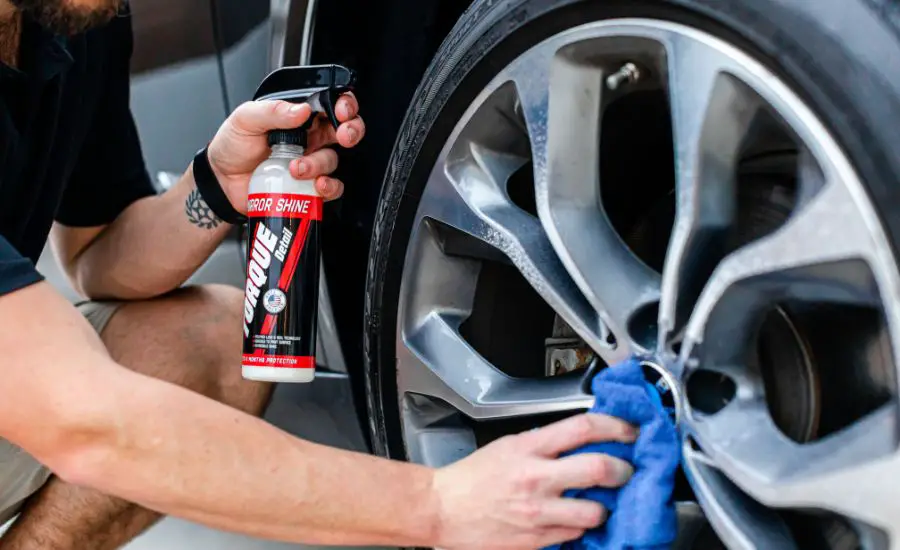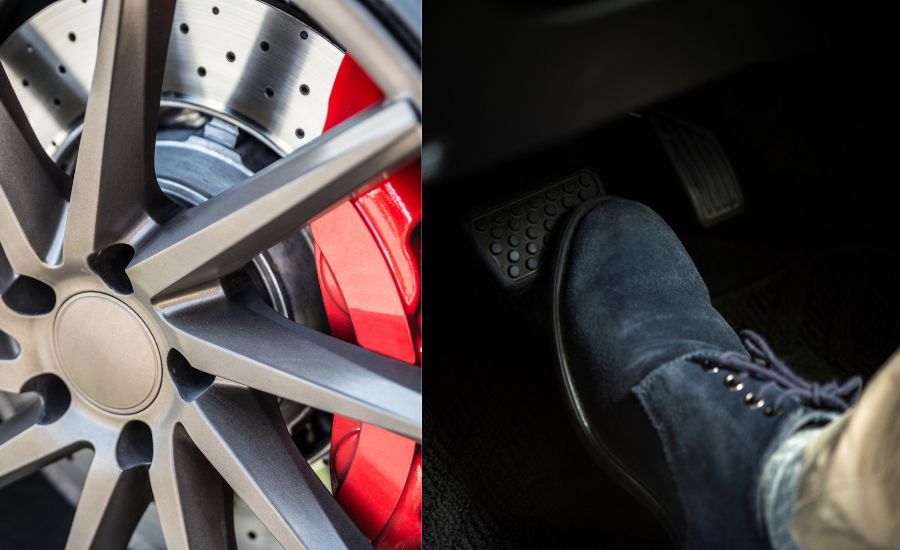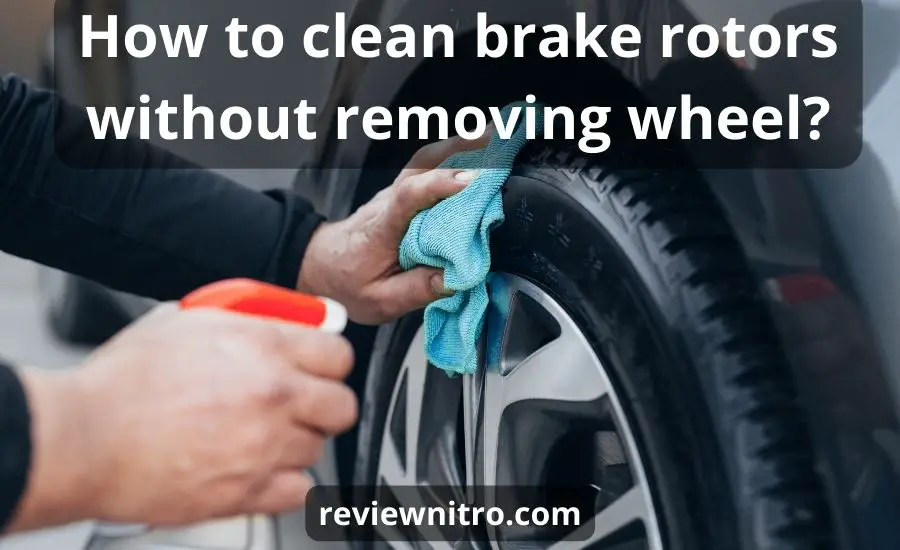Ensuring the cleanliness and optimal functionality of your car’s brake rotors is crucial for both safety and performance.
Indications of a dirty car’s brake rotors may manifest as vibrating steering wheels and brake pedal, or a brake squeal. While the traditional approach involves removing the steering wheel for rotor cleaning.
Thankfully, efficient techniques are available for cleaning car brake rotors without needing to remove the wheel. In this article, we will delve into the process of cleaning disc rotors and brakes.

Table of Contents
Importance of regular brake rotor maintenance
Before exploring how to clean brakes, it is important to emphasize the significance of your brake pad material.
Neglected brake pads tend to accumulate brake dust, dirt, and other harmful contaminants.
This buildup can result in reduced braking efficiency and potential damage to the braking mechanism, necessitating new brake pads.
Regularly cleaning your brake rotors allows you to eliminate these detrimental substances, thus ensuring a seamless and responsive braking experience.
Precautions to take before cleaning brake rotors
To clean brake pads without removing the wheel, prioritizing safety and implementing necessary precautions is of utmost importance.
First and foremost, equip yourself with protective gloves and eyewear to safeguard against any potential hazards.
By taking these precautions, you establish a safe working environment and mitigate risks associated with the cleaning procedure.
Safety should always remain paramount when engaging in car maintenance tasks involving the braking mechanism of your vehicle.
Choosing the right brake rotor cleaner
Selecting an appropriate cleaner for brake rotors is crucial to achieving optimal cleaning outcomes.
It is essential to choose brake cleaners that are specifically formulated for brake pads, as these products are designed to effectively eliminate brake dust (a brake dust remover), dirt, and oil.
Give preference to high-quality brake cleaners that are renowned for their efficacy in cleaning brake pads, while also ensuring the safety of the components involved. One such example is the Sonax wheel cleaner, which is known for its effectiveness and compatibility with brake pads.
Using brake cleaner spray for rotor cleaning
Using a brake cleaner spray provides a convenient and effective method. To use brake cleaner spray, begin by raising the vehicle with a jack and securing it with jack stands for enhanced safety.
Next, identify the brake calipers and rotors situated behind the wheel. Directly apply the brake cleaner spray onto the surface of the rotor, allowing the brake cleaner to penetrate the surface for a few minutes.
Additionally, take the opportunity to inspect if there is a leaky brake caliper units.
A step-by-step guide to cleaning brake rotors without removing the wheel
Using brake cleaners without removing the wheel is a convenient method to maintain the cleanliness and performance of your vehicle’s braking system.
By following a detailed step-by-step guide, you can successfully get clean brakes.
In the following section, we will explore each step of the process in detail, offering a thorough explanation of how to clean brake rotors without removing the wheel and how to effectively utilize most brake cleaners.
Step 1: Removing brake dust and debris from the rotor surface
To begin the brake cleaning process, the initial step involves eliminating loose brake dust and debris from the surface of the rotor.
Carefully and meticulously scrub the rotor by utilizing a stiff brush or wire brush. Additionally, employing an air blower can be beneficial, as an air blower aids in the removal of dust particles.
Step 2: Inspecting the rotor for any signs of damage or wear
When cleaning the brake rotors, it is recommended to utilize this opportunity to thoroughly examine them for any indications of damage or brake pads wear.
Pay attention to the rotor surface and carefully inspect for deep grooves, cracks, or uneven wear. Should any notable problems be observed.
Step 3: Applying the brake cleaner to the rotor surface
Proceed to apply brake cleaner by spraying it directly onto the rotor surface. Brake cleaner is specially designed to effectively dissolve persistent brake dust, brake fluid, and other undesirable substances.
Step 4: Scrubbing the rotor surface to remove stubborn dirt or grime
Utilize a firm brush or steel wool to vigorously scrub the surface of the rotor, eliminating any persistent dirt or grime. Apply moderate pressure and employ circular motions to ensure the effective dislodgment and elimination of contaminants.
Step 5: Use a brush or cloth to clean the rotor vents and edges
Aside from cleaning the surface of the rotor, it is crucial to give proper attention to the rotor vents and edges. These specific areas are susceptible to collecting brake dust and debris, which can have a detrimental effect on the overall performance of the brake system.
To guarantee a comprehensive cleaning process, use a brush or cloth to access these regions and eliminate any buildup.
Step 6: Wiping down the rotor with a clean cloth or paper towel
Once you have thoroughly scrubbed the rotor surface and attended to the vents and edges, take a clean cloth or paper towel and carefully wipe away any remaining residue or excess brake cleaner.
This particular step is vital in guaranteeing that the rotor surface is left impeccably clean and prepared for subsequent maintenance tasks.
Step 7: Repeating the cleaning process for each brake rotor
For every brake rotor on your vehicle, repeat the aforementioned steps. It is crucial to apply the same degree of cleaning and meticulousness to each brake rotor, as this ensures uniform performance throughout the entire brake system.
Step 8: Drying the rotors thoroughly to prevent rusting
After completing the cleaning procedure, it is essential to let the brake rotors air dry entirely. Alternatively, you may utilize an air blower to expedite the drying process.
Ensuring that the rotors are completely dry is crucial in preventing the accumulation of rust and corrosion, thereby preserving their longevity and performance.
Step 9: Applying a protective coating or lubricant to the rotor surface
To enhance protection against rust and corrosion, you may want to contemplate using a specialized protective coating or lubricant designed specifically for brake rotors.
By applying these products, you can establish a shield that repels moisture and safeguards the cleanliness of the rotor surface.
Step 10: Reassembling the brake components and test the brakes
After the rotors are dry and protected, carefully reassemble the brake components, like rotors, brake discs, brake shoes, and brake linings. Perform a brake test to ensure that the brakes are functioning correctly and respond as expected.
By following these step-by-step instructions, you can effectively clean dirty brake rotors effortlessly and without removing the wheel.

Conclusion
Maintaining clean and functional brake rotors is essential for the proper operation of your vehicle’s braking mechanism.
By adhering to a systematic approach and utilizing a suitable brake cleaner, you can effectively eliminate dust, dirt, brake fluid, and other unwanted substances from the rotors.
Always prioritize safety and incorporate regular maintenance practices to ensure your brake rotors remain in optimal condition. Utilizing a specialized brake or wheel cleaner can assist in achieving this goal.
FAQ
Cleaning brakes without removing the wheel involves using brake cleaner spray and following a step-by-step process.
This allows you to remove dust, brake fluid, dirt, and other contaminants without the need to disassemble the braking system.
Yes, spray brake cleaner can be used directly on the rotors. Brake cleaner is formulated to dissolve dust, dirt, and oil, making it an effective cleaning agent for rotor surfaces.
You can clean disc brakes with brake cleaner specifically designed for this purpose. Brake cleaner is formulated to remove dust, dirt, and oil without causing damage to the braking system, so you can use them to clean disc brakes.
It is not recommended to use rubbing alcohol as a brake cleaner. Rubbing alcohol may not effectively remove dust and other contaminants, and it may not be suitable for the high temperatures in the brake rotors and brake discs.
Remember to consult your vehicle’s manual and follow the manufacturer’s recommendations for brake cleaner and maintenance procedures.



1 thought on “How to Clean Brake Rotors Without Removing Wheel: Best Cleaners”